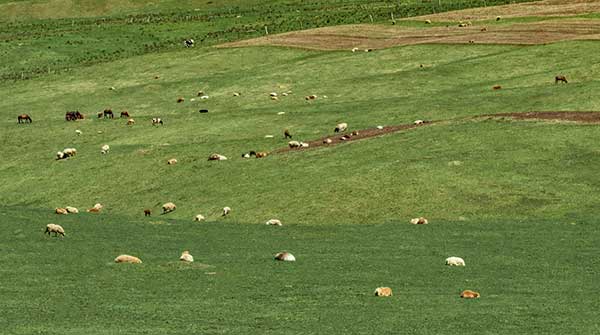Climate change-driven droughts could devastate grasslands
Intense short-term drought driven by climate change is likely to have a much worse effect on the world’s grasslands than previously thought, according to University of Alberta researchers involved in an international study.
An experimentally imposed year-long drought on grasslands and shrublands in Africa, Asia, Australia, Europe, North America and South America resulted in a 60 percent greater loss in plant growth under the extreme conditions, compared with more common historical drought patterns.
The groundbreaking collective study, conducted by more than 170 researchers, is the first to use a standardized experiment worldwide to provide a big-picture projection of intense drought extremity.
 Cameron Carlyle |
 Edward Bork |
 Scott Chang |
 James Cahill |
 Photo by Yang |
| Related Stories |
| Grazing mirroring natural patterns protects grasslands from drought
|
| Climate change a threat to Prairie agriculture
|
| Plant diversity promotes healthier land: study
|
“What the finding tells us is that we have underestimated, so far, the impacts of short-term extreme drought on grassland systems,” says Cameron Carlyle, a rangeland ecologist in the Faculty of Agricultural, Life & Environmental Sciences and one of five U of A co-authors on the study.
The finding is worrisome because short-term droughts – a year or less in duration – are becoming more common around the globe, he adds.
“We haven’t experienced these types of extreme droughts very often in the past, but they are likely to be more frequent in the future due to climate change, and that is concerning because grassland plants drive important ecosystem services we depend on, like carbon sequestration.”
Grasslands and shrublands are ecologically vital around the world. Covering more than 40 percent of the world’s ice-free land surface, the ecosystems often have low and variable rainfall, making them vulnerable to climate change. At the same time, they store more than 30 percent of the world’s carbon stocks.
The large-scale research project provides “a clear understanding of whether extreme drought differs from normal historical droughts in terms of impact on plant growth, and which areas will be most affected,” says Batbaatar Amgaa, who led the U of A portion of the research to earn a PhD in ecology in the Faculty of Science.
“The magnitude of drought effects have been uncertain in scientific literature due in part to differences in research methodology among studies done at different locations and the past rarity of short-term extreme drought,” adds Amgaa, whose study co-authors included U of A professors Edward Bork and Scott Chang from the Faculty of Agricultural, Life & Environmental Sciences and James Cahill from the Faculty of Science.
“This now shows the global effect of severe short-term drought, which is expected to be the new normal.”
For the experiment, researchers reduced rainfall by placing transparent plastic structures over vegetation at 100 grassland and shrubland sites in various regions of the world, then compared the growth of the sheltered plants with those in adjacent uncovered areas.
Collectively, the findings showed that one year of statistically extreme drought – defined as a one-in-100-year event – resulted in a 60 percent greater loss of plant production than at sites where drought magnitude was within the historical range.
That means that besides sequestering less carbon, the grasslands could produce less forage for livestock producers around the world to feed their cattle, says Amgaa, who conducted the experiment locally at the U of A’s Mattheis Research Ranch and Roy Berg Kinsella Research Ranch.
“This could result in supply issues that drive up the price of feed.”
The experiment also revealed that drier sites with less diverse plant life in places such as the southern United States and even parts of southern Alberta are likely to be the most vulnerable to extreme drought.
“This shows why maintaining plant biodiversity is important,” says Carlyle. “In a pool of many grasses or flowering plants, there’s likely to be more drought-tolerant species.”
Overall, the research can help guide more strategic management to make grasslands less susceptible to climate change and drought, he adds.
“In Alberta, that means exploring ways to change how we manage cattle on the landscape to make the land more resilient to drought,” he suggests, noting that U of A research has already shown some promising results.
On a global scale, the study also provides crucial data for climate modelling, Carlyle says.
“Being able to incorporate such a large reduction in plant growth as a result of these extreme droughts will help refine and change the outcomes of climate change models. That can aid better understanding of climate effects and plant and forage production forecasting.”
| By Bev Betkowski
This article was submitted by the University of Alberta’s Folio online magazine, a Troy Media Editorial Content Provider Partner.
The opinions expressed by our columnists and contributors are theirs alone and do not inherently or expressly reflect the views of our publication.
© Troy Media
Troy Media is an editorial content provider to media outlets and its own hosted community news outlets across Canada.
